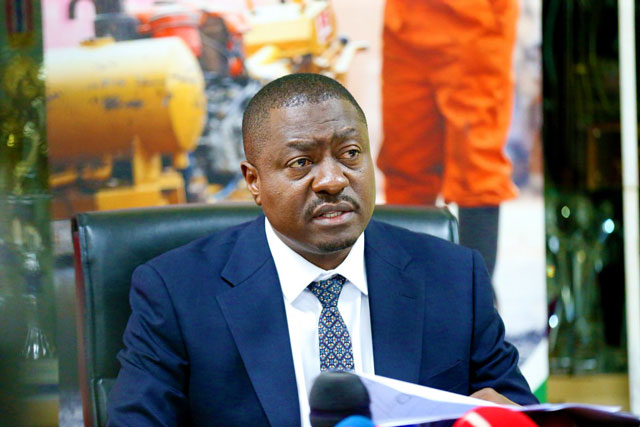
Dr. Godfrey Mwesige, a lecturer in the Department of Construction Economics and Management at Makerere University’s College of Engineering, Design, Art and Technology told The Independent on June 14 in an email that Kampala’s drainage channels do not only carry storm water only but also silt and garbage which constantly blocks the channels.
He said there has been severe encroachment, reducing the effective primary channel widths to accommodate storm water discharges after a sustained storm. These constrictions act like mini dams, creating the observed floods on the upstream because storm water is not being discharged at the same rate it is being generated.
Mwesige told The Independent that in order to solve this problem, there is need for Government intervention to relocate persons along the primary channels and swamps.
Jude Tadeieus Kyobe, a roads engineer at the Uganda National Roads Authority (UNRA) told The Independent on June 14 that when UNRA was planning to construct the Kampala Northern Bypass road which touches the Lubigi wetland, the authority did a comprehensive drainage study of the entire catchment.
The study found that drainage problems along the Northern Bypass were caused by two major issues and both were man-made; unplanned and uncontrolled construction within the waterway and dumping garbage within the drainage channels causing blockage.
Kyobe says the Lubigi channel is heavily clogged from Hoima road downstream of the channel. This means the storm water from the elevated areas of Makerere, Nakulabye, Nalukolongo, Kigaga Rubaga, and even Kyebando, Kawala is constrained and forced to flow backwards into the upstream zones where it comes from. This is what causes floods.
The UNRA study, Kyobe says recommended numerous interventions to tackle the drainage problem along the road corridor. Among the interventions was the construction of high capacity drainage structures as well as replacing existing ones with larger ones.
“The constructed structures include several box culverts at Sentema North, Namungoona round about, Kalerwe and Kyebando.” But this is not enough, Kyobe adds. UNRA intends to engage a contractor to continuously desilt and rid the channel of garbage; especially following heavy downpours.
Dr. Amin Tamale Kiggundu of the Department of Architecture and Physical Planning at Makerere University agrees that Kampala city needs to invest in infrastructure to manage Kampala’s floods. The design and construction and interconnectivity of drains need to be improved to avoid clogging and blockage.
However, Kiggundu also quickly notes that the city authority’s failure to decisively deal with floods is due to the fact that it lacks enough resources. He is advocating new sourcing models to overcome the cash squeeze.
“There is a lot of dependence on the central government and donors and this is not sustainable,” Kiggundu says.
He told The Independent that Kampala probably needs to consider public-private partnerships to solve some of its infrastructure challenges and insists KCCA needs to learn from other cities that tend to flood.
The new financing models Kiggundu is pushing for are similar to global expert Prof. Paul Collier, the director of the International Growth Centre recommended to KCCA in 2016.
While giving a lecture titled, “What Policies would make Kampala a Great 21st Century City?” hosted by Bank of Uganda and KCCA, Collier said development of the city should be undertaken largely by the private sector.
Kiggundu also told The Independent that KCCA needs to start thinking about city residents, especially property owners, shouldering some of Kampala’s funding burden.
“Having property in a livable neighbourhood means the owners’ property gaining value,” he said.
Cities and floods
Kampala is not the only city grappling with flooding. Abnormal rainfall in 2017 caused unusual floods in Mumbai, Dhaka, and Kathmandu in South Asia killing at least 1,200 people. Planners in these and many other cities are trying to respond on how to cope.
In a 2014 paper titled, “Making Cities more resilient to flooding,” Michael Hammond, a research fellow at the University of Exeter’s Centre for Water Systems noted that flooding in urban areas is a partially pressing problem in cities because they are highly concentrated centres of human and economic activity.
Hammond said cities have tended to respond reactively to floods, and have relied on purely structural solutions to increase flood protection such as constructing higher dikes and larger drainage systems but they have found that it is not possible to provide absolute protection to city dwellers through structural mitigation measures.
Instead, a new model has evolved known as “flood resilience,” which aims at improving the way cities and its citizens cope with flooding; rather than fighting floods. Hammond gives the example of the flood-prone Spanish city of Barcelona which has embedded the principle of robustness in its urban drainage system.
“It has installed underground storage tanks with gates which can be controlled in real-time,” he said, “Rainfall forecasting systems are also being improved so that emergency services and citizens have the information they need to prepare and respond.”
Such planning is in line with what Amanda Ngabirano, a lecturer of urban and regional planning in the Department of Architecture and Physical Planning at Makerere University, wants. She told The Independent on June 06 that “floods are about water management and water management is about planning.”
“If we don’t plan, we plan to fail. We have failed with water and flooding in Kampala,” Ngabirano told The Independent.
“We must invest in a comprehensive master plan for the city, prioritize its implementation, and get rid of some structural developments in some environmentally sensitive areas.”
“Even if our population still requires sensitization and attitude change, it is the public sector expected to initiate such programmes, which should run over a long period of time,” Ngabirano told The Independent.
She says Kampala’s floods are not all about drainage channels, but a complete city set-up and land use pattern, based on a plan.
Mujuni agrees. He says Kampala too needs to change the way it does its things.
“We need to strengthen the enforcement mechanism to protect the remaining wetlands besides improving the tree cover around Kampala.”
Mujuni added: “It is high time Kampala did an upgrade of its only weather station at Makerere University.”
He says Kampala’s economic importance needs special attention and the government could help by investing in a better weather station network for the city.
“Each of Kampala’s five divisions needs to have a modern weather station so that the meteorologists can understand the rainfall patterns of each of these divisions,” Mujuni said, “You find that sometimes what happens in Kawempe may not necessarily happen in Rubaga or Nakawa.”
****
 The Independent Uganda: You get the Truth we Pay the Price
The Independent Uganda: You get the Truth we Pay the Price


